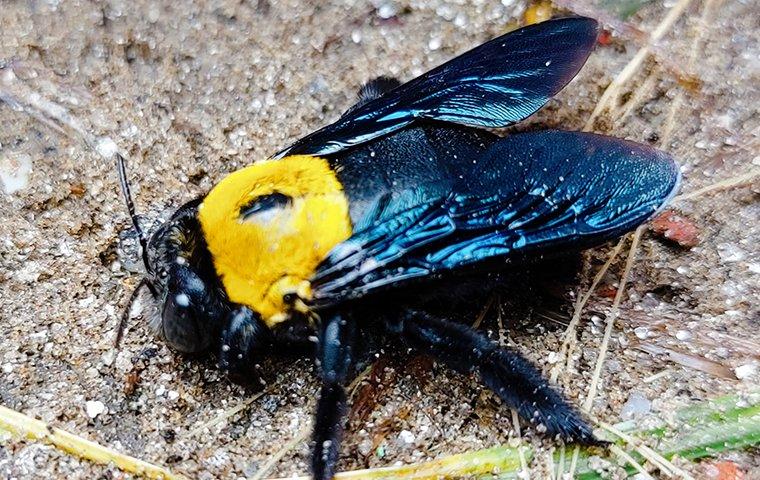Spring is on its way, and soon dormant plants and creatures will wake from their winter slumber. Birds will sing, bees will buzz, and hopefully, neither of them will become a nuisance to your Hudson Valley home. Carpenter bees will be on the move and looking for a good place to settle down and multiply. Surely, your home isn’t on their shortlist, or is it?

What Is A Carpenter Bee?
Carpenter bees are small winged insects, ¼ inch to 1 inch long with six legs. They have an appearance that is like a bumblebee, however, they trade the hairy, yellow abdomen for a sleek black body with a patch of yellow hair on their thorax. Carpenter bees are solitary bees. Unlike bumblebees, they prefer their own company to hives and swarms. You will usually find them hanging out near the small holes they bore into wooden structures.
Female carpenter bees will bore holes into the exterior of your home. They create a series of tunnels, called galleries. They use these galleries to lay their eggs and protect their larvae. These holes don't cause serious structural damage alone, but they do invite wood-decaying fungi and carpenter ants to the party, which are both highly destructive. Furthermore, woodpeckers enjoy feasting on carpenter bee larvae, and they will add to the damage trying to extract their meal from the galleries.
Signs Of A Carpenter Bee Problem
Identifying carpenter bees on your property is relatively easy once you know what to look for. Signs of carpenter bees include:
Small, circular holes in wooden structures such as the exterior of your home, decks, porches, and wooden fencing.
- Sawdust near the holes drilled by the carpenter bees.
- Pollen and bee excrement near the entrance holes of the galleries.
- Male carpenter bees flying around outside the holes.
Carpenter bees are more dangerous to your property than they are to people unless they have an allergy to bees. Male carpenter bees are fiercely protective of their territory, but they lack stingers. The females have stingers, but being stung is highly unlikely unless provoked.
Carpenter Bee Prevention Tips
You can easily deter carpenter bees from making themselves at home on your Hudson Valley property. They are attracted most to unfinished or exposed wood, so painting with oil-based paint or sealing the wood with polyurethane will help to keep them away. Using non-wood or chemically treated materials like aluminum flashing, vinyl siding, or pressure-treated wood will also protect your home.
It’s important to seal any existing holes or cracks with silicone caulk, keep doors shut, and keep window screens in good repair. Carpenter bees will often inhabit galleries made by other carpenter bees before them and extend the tunnels, so it’s imperative to repair any damages as you find them to prevent further damage to your home.
What To Do If You Suspect Your Home Has Carpenter Bees
If you suspect that you may have a carpenter bee problem in your Hudson Valley home, our licensed service professionals at Pestmaster® Services have the knowledge and experience necessary to provide you with quality service you can trust. Once we have completed our thorough inspection, we will come up with a plan that best suits your family’s particular needs. When we treat, we make sure to do so safely so that we don't harm the health of you, your family members, or your pets.
Reach out to the professionals at Pestmaster® Services today to learn more about how you can control your carpenter bee problem!
.png)
